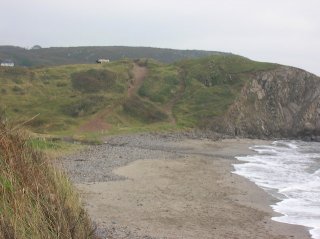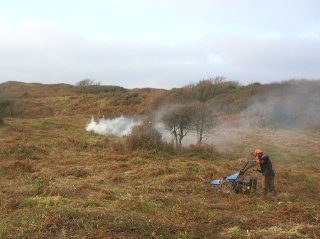 The many thousands of locals and visitors alike which stream onto Kennack Sands during the Spring and Summer months may well be unaware that a National Nature Reserve backs onto the beaches where they will be spending time picnicking and body-boarding. With the exception of the occasional Outreach or educational activity the NNR team generally has a fairly low profile during these months of the year. However, as the days of autumn shorten and grow cooler, the annual management regime for the dune system swings into life. A regular visitor to Kennack would soon be aware of the construction of an elaborate temporary fenced enclosure, followed very quickly afterwards by the arrival of a number of Shetland ponies. In the months that follow there will be several days of noisy activity as scrub is cleared and burnt. After a while both the ponies and the fencing disappear and quiet descends once more until the return of warmer days and beach-goers.
The many thousands of locals and visitors alike which stream onto Kennack Sands during the Spring and Summer months may well be unaware that a National Nature Reserve backs onto the beaches where they will be spending time picnicking and body-boarding. With the exception of the occasional Outreach or educational activity the NNR team generally has a fairly low profile during these months of the year. However, as the days of autumn shorten and grow cooler, the annual management regime for the dune system swings into life. A regular visitor to Kennack would soon be aware of the construction of an elaborate temporary fenced enclosure, followed very quickly afterwards by the arrival of a number of Shetland ponies. In the months that follow there will be several days of noisy activity as scrub is cleared and burnt. After a while both the ponies and the fencing disappear and quiet descends once more until the return of warmer days and beach-goers.
The Lizard NNR is largely made up of lowland heathland and coastal grassland, as well as a number of other minor habitats – the management of several of these can be readily incorporated into our general management prescriptions. Since Kennack Towans is the only dune system to be found on the reserve, it requires us to focus our attention more keenly on the mechanics of how it is managed. Up until the post-war period the dune grassland, indeed much of Gwendreath valley, was far more open than we see it today. This was maintained in no small part by cattle roaming down to the shore from near-by farms and a large population of rabbits, all of which grazed away at the available vegetation. The face of this seemingly unchanging habitat was then altered as a variety of factors – agricultural intensification, the rise of mass tourism and the advent of myxomatosis – led to the demise of grazing, with the result that the valley became much more wooded and the dune succumbed to scrub.
 By the time some ideas for managing the towans were put together in 2007 almost the entire habitat was covered in scrub, save for a few routes which people followed to cross it and reach the eastern beach. It was always intended that a combination of scrub clearance and pony grazing was the best means of opening up and restoring the towans to their former glory. At first this grazing was scheduled for the very end of the winter, but we soon discovered that the ponies were trampling the increasing numbers of emerging bluebells which were responding favourably to the scrub clearance. As a consequence the grazing period was altered to run from October to Christmas, when the flora would be more dormant. Each winter since has seen a new block of scrub cleared whilst areas of re-growth are re-visited and given a follow up trim with a brush-cutter. It has never been the intention to completely eliminate all the scrub, but rather to create a mosaic of ‘islands’ of bushier vegetation within a wider area of shorter floristically richer grassland.
By the time some ideas for managing the towans were put together in 2007 almost the entire habitat was covered in scrub, save for a few routes which people followed to cross it and reach the eastern beach. It was always intended that a combination of scrub clearance and pony grazing was the best means of opening up and restoring the towans to their former glory. At first this grazing was scheduled for the very end of the winter, but we soon discovered that the ponies were trampling the increasing numbers of emerging bluebells which were responding favourably to the scrub clearance. As a consequence the grazing period was altered to run from October to Christmas, when the flora would be more dormant. Each winter since has seen a new block of scrub cleared whilst areas of re-growth are re-visited and given a follow up trim with a brush-cutter. It has never been the intention to completely eliminate all the scrub, but rather to create a mosaic of ‘islands’ of bushier vegetation within a wider area of shorter floristically richer grassland.
Among the many delights in recent years has been the notable increase in the populations of a variety of plants, such as Devilsbit Scabious and Meadow Clary, together with more unusual specimens such as Stinking Iris and Butcher’s Broom. The latter, more usually associated with scrub and woodland habitats on chalk, thrives here and even responds well to accidental cutting back during scrub clearance work. An equal delight has been to reveal the true ‘lay of the land’ as the scrub cover has been removed. Features dating from the Second World War, such as the defensive walls and pillbox, were already known. Clearing away the scrub revealed hidden features such defensive ditches and foxholes which had been covered for decades. I find this especially poignant as my grandfather spent many hours of his Home Guard service at Kennack and may well have dug out the very features that our clearance work has revealed.
 |
 |
Of one thing I am certain – namely, that our battle with scrub will almost certainly last longer than my grandfather’s battle with Hitler. The cutting back of blackthorn and bramble has not only created opportunities for a variety of flowering plants but also given space to that aggressive invader, bracken. This has become much more noticeable on those areas cleared in recent years and will almost certainly require us to open up a second front of scrub management during the summer months. Until such time as the scrub is in check there will always be days for brushcutters and bonfires; and until a passing brigade of rabbits once more takes up residency within the towans there will always be a place for ponies. So, should you find yourself clearing your head down at Kennack Sands over the festive period, take the time to wander up into the towans and wish the ponies a ‘Merry Christmas’ and congratulate them on a job well done.

Published: Dec 2013
Author: Duncan Lyne
Click here for more articles about conservation work on the Lizard.
